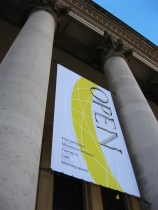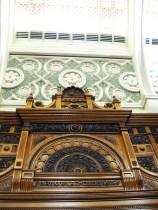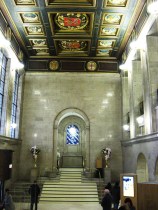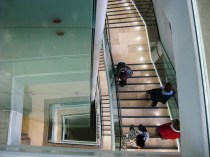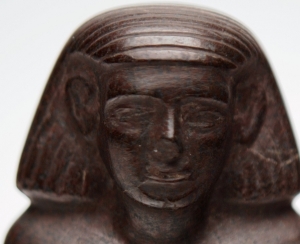How often do you watch a grown adult sleep? Maybe your partner, maybe a member of your family, maybe even a friend but chances are you very rarely catch a stranger in repose and even if you do, it is likely to be a fleeting moment rather than sitting in the same space, observing their shape, the way they turn, creeping past them, whispering with your friends so as not to disturb them – this would be a rare experience. And even if you did have such experiences you (hopefully) would keep the image off of social media… that is, unless it’s art.
 The initial question was asked by Maria Balshaw, director of Whitworth Art Gallery, at the official opening of both the summer season and Coal on Cotton, a 65-hour performance piece by Nikhil Chopra taking place at the gallery as part of Manchester International Festival. She, and other foolhardy devotees had been at the gallery from 4.30am on Friday to witness the start of Chopra’s opus to Manchester and Mumbai’s industrial connections through two materials that put the cities on the world’s stage. Chopra, known for portraying characters throughout his performance based art, started as ‘the Farmer’, sleeping on bales of locally woven Indian cotton for the first 40minutes, watched by the small, exclusive crowd. The first I (and probably most others) saw of it was through photos of this intimate scene posted on Twitter by the press, marketers and the gallery. Although Balshaw spoke of the profound silence that descended as Chopra slept, this reverential moment was already being spread throughout the city and the world.
The initial question was asked by Maria Balshaw, director of Whitworth Art Gallery, at the official opening of both the summer season and Coal on Cotton, a 65-hour performance piece by Nikhil Chopra taking place at the gallery as part of Manchester International Festival. She, and other foolhardy devotees had been at the gallery from 4.30am on Friday to witness the start of Chopra’s opus to Manchester and Mumbai’s industrial connections through two materials that put the cities on the world’s stage. Chopra, known for portraying characters throughout his performance based art, started as ‘the Farmer’, sleeping on bales of locally woven Indian cotton for the first 40minutes, watched by the small, exclusive crowd. The first I (and probably most others) saw of it was through photos of this intimate scene posted on Twitter by the press, marketers and the gallery. Although Balshaw spoke of the profound silence that descended as Chopra slept, this reverential moment was already being spread throughout the city and the world.
I arrived much later, stepping through a fire exit door, into a half constructed corridor bathed in summer sun. Another aspect to the piece was that Whitworth Art Gallery are closing in September while a new £15million extension is completed. Chopra’s performance would be based in what will be the new landscape gallery but at the moment was open to the notoriously fickle Manchester weather. ‘The Farmer’ had combated this by constructing a large tent from the cotton bales he’d slept on then dragged through the galleries earlier. As I stepped in to this private/public space, I was first struck by how beautiful it was, like a communal cocoon of diffused light, the smell of the material evoking memories of camping trips and Bradford cloth stops. Chopra himself was now in his second incarnation ‘the Mill Worker’, dressed in Victorian style, monochrome, trousers and shirt that reflected the charcoal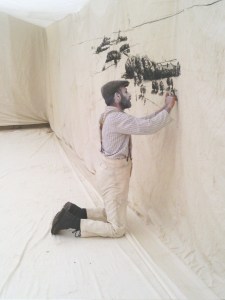 drawing he was deftly inscribing on the wall of the tent. His face was covered in chalk giving him the appearance of a ghost among the pale shades surrounding him and us. The overall effect was one of serenity and acceptance. If seeing a stranger sleep is a rare event, seeing them in the act of artistic creation is probably even rarer. Yet, we weren’t an intrusion, despite his forced non-interaction pierced by occasional accusatorial stares in our direction. We seemed to share in this job of work, peace descending as we watched him draw, stride to his reference photograph and return. We sat against the far wall, examined the photograph ourselves, peeked out of the window cut roughly in the side, talked quietly with friends and strangers alike, and ubiquitously recorded the experience in real time through our smart phones.
drawing he was deftly inscribing on the wall of the tent. His face was covered in chalk giving him the appearance of a ghost among the pale shades surrounding him and us. The overall effect was one of serenity and acceptance. If seeing a stranger sleep is a rare event, seeing them in the act of artistic creation is probably even rarer. Yet, we weren’t an intrusion, despite his forced non-interaction pierced by occasional accusatorial stares in our direction. We seemed to share in this job of work, peace descending as we watched him draw, stride to his reference photograph and return. We sat against the far wall, examined the photograph ourselves, peeked out of the window cut roughly in the side, talked quietly with friends and strangers alike, and ubiquitously recorded the experience in real time through our smart phones.
Although there was official documentation, this amateur recording over the three days will no doubt prove the more interesting. I, for one, felt compelled to capture the progress of the drawing, the beauty of the space, the small collection of bundles containing his possessions for the three days. Speaking to one of the visitor assistants, at first they’d assumed cameras would be banned but Chopra had been happy for his ‘guests’ to share the piece with those outside the gallery. Rather than the negative experience iPads at gigs can be, this sharing seemed respectful, beautiful, intimate. I felt that by sharing my experience I was preserving it, as much for me as for the gallery or the world, capturing it and sending it like little bottles of insight on the ocean of Twitter, that I could retrieve and feel a little of what I felt watching this man work.
The last day was fervent with activity. As I arrived he was transforming into his last character, ‘the Boss’, clean shaven except for an impressive handlebar moustache, dressing in bright green to the jarring sound of looms recorded at the area’s last working steam-driven mill. The space was filled with excitement and portent, suddenly loosing it’s lazy, serene nature as our protagonist transformed. The first sound I heard him make in the three days I’d been visiting was a whistle to bring in several workers in hard-hats and luminous tabards. Ripping the tent apart with precision, Chopra quietly gave orders, pointing, gesturing, animated. Gone was the quiet, introverted ‘worker’, replaced by magnet, all business, calling us out of the collapsing tent and into the white heat of the roofless, concrete, half-built gallery. Fascinated, we stayed watching his construction descend, his persona fully finished with a beautifully tailored jacket and exotic flower boutonniere. We followed his every move, like a pied piper’s rats as his minions carried the wrapped cotton through to the front of the gallery, continually recording the breakdown of our former sanctuary.
 By the time the drawing was hoisted roughly across the brick entrance, there was perhaps a hundred strong crowd watching Chopra peacock, an artistic superstar, in charge of these closing moments and seemingly the sun itself as it descended behind the city. We spread his image, simultaneously, no longer his equal as we had felt with the ‘worker’ but his sub-creatures, mythically transformed by his achievement as he had been. When he eventually left us, simply stepping down from the table he used as his stage and walking away, few followed. We had our place and now it wasn’t with him. Our power remained in the procreation of his image, the one flying through the air. Chopra may have been speaking to Manchester’s industrial past, its great innovation that caused such hardship to those who flooded to its factories, a process repeated in new industrial centres such as Mumbai now. But we used new innovation to share that experience, his and ours, a new collective that brings with it joys and woes, a new tool that we strive to make our own and retain, celebrate, preserve a little creativity of our own.
By the time the drawing was hoisted roughly across the brick entrance, there was perhaps a hundred strong crowd watching Chopra peacock, an artistic superstar, in charge of these closing moments and seemingly the sun itself as it descended behind the city. We spread his image, simultaneously, no longer his equal as we had felt with the ‘worker’ but his sub-creatures, mythically transformed by his achievement as he had been. When he eventually left us, simply stepping down from the table he used as his stage and walking away, few followed. We had our place and now it wasn’t with him. Our power remained in the procreation of his image, the one flying through the air. Chopra may have been speaking to Manchester’s industrial past, its great innovation that caused such hardship to those who flooded to its factories, a process repeated in new industrial centres such as Mumbai now. But we used new innovation to share that experience, his and ours, a new collective that brings with it joys and woes, a new tool that we strive to make our own and retain, celebrate, preserve a little creativity of our own.


